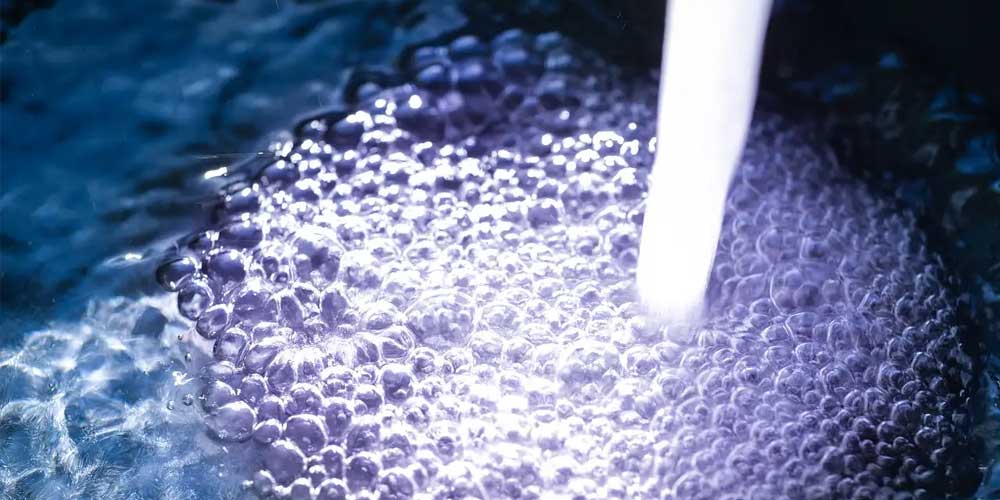Ko nga antifoams Silicone he mea tito mai i te silica hydrophobized kua marara ki roto i te wai silicone. Ko te pūhui hua ka whakapūmauhia ki roto i te whakaehunga wai, hinu ranei. He tino whai hua enei antifoams na te koretake o te matū matū, te kaha ahakoa te iti o te kukū, me te kaha ki te hora ki runga i te kiriata pahuka. Mena e hiahiatia ana, ka taea te whakakotahi ki etahi atu totoka hydrophobic me te wai hei whakapai ake i o raatau taonga whakaheke.
Ko nga kaihoko antifoam Silicone e pai ake ana. Ka mahi ratou ma te wawahi i te mahanga o te mata me te whakapouri i nga mirumiru pahuka, ka hinga. Ko tenei mahi ka awhina i te whakakore tere o te pahuka i te waa, ka awhina ano hoki ki te aukati i te hanga pahuka.
Nga painga o te silicone defoamer
• Te whānuitanga o nga tono
Na te hanganga matū motuhake o te hinu silicone, karekau i te hototahi ki te wai, ki nga matū kei roto nga roopu polar, me nga waiwaro, matū waro ranei kei roto nga roopu waiwaro. I te mea he koretake te hinu silicone i roto i te maha o nga matū, he maha nga tono a te silicone defoamer. Ka taea te whakamahi ehara i te mea mo te whakakore i nga punaha wai, engari mo nga punaha hinu.
• He iti te mahanga o te mata
Ko te mata o te hinu silicone he 20-21 dynes/cm he iti ake i te mata o te wai (72 dynes/cm) me te wai pahuka i te nuinga o te waa, e pai ake ai te mana o te pahuka.
• Te pai o te waiariki
Ma te whakamahi i te hinu hinu silicone dimethyl hei tauira, ka taea e tona parenga pāmahana mo te wa roa te tae ki te 150°C, a ka taea e tona parenga pāmahana mo te wa poto te eke ki runga i te 300°C, me te whakarite ka taea te whakamahi i nga apiha whakangao silicone i roto i te whānuitanga o te pāmahana.
• He pai te pumau matū
Ko te hinu Silicone he tino pumau matū, he uaua ki te tauhohe matū me etahi atu matū. No reira, i te mea e tika ana te whakarite, ka whakaaetia kia whakamahia nga miihini whakangao i roto i nga punaha kei roto nga waikawa, alkali, me nga tai.
• Te ngoikore o te tinana
Ko te hinu Silicone kua whakamatauhia kia kore e paitini ki te tangata me nga kararehe. Na reira, ka taea te whakamahi humarie i roto i te penupenu me te pepa, te tukatuka kai, te rongoa, te rongoa, te rongoa me te whakapaipai.
• Te whakakore pahua kaha
Kaore e taea e nga kaitapahu silicone te pakaru noa i te pahuka i te kore e hiahiatia, engari ka tino aukati i te pahuka me te aukati i te hanga o te pahuka. He iti rawa te inenga, a ko te kotahi miriona (1 ppm, 1 g/m3) noa iho o te taumaha o te momo pahuka ka taea te taapiri kia puta he hua whakapoka. Ko tana awhe noa he 1 ki te 100 ppm. Ehara i te mea he iti noa te utu, engari e kore e poke i nga taonga e whakakorehia ana.
Ka whakanuia nga antifoams silicone mo te pumau, te hototahi ki nga momo matū, me te whai hua ki nga kukū iti. Heoi, he mea nui ki te whakarite kia u ki nga paerewa ture me te pai mo te tono motuhake hei karo i nga paanga kino ki te kounga o te hua me te taiao.
Te wa tuku: Apr-18-2024


